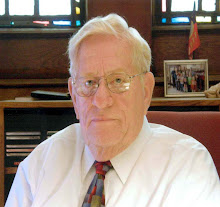The Rev. Dr. David Eberhard presents an article called “Dr. Eberhard Speaks Out”. He challenges us with his thoughts and experience as a leading churchman in America. While we may agree, or not agree, he shares with us what he has learned that works in the local parish. Over his fifty years of experience in the ministry, and 24 years in the political arena, he has always tended to be ahead of the current curve and is always “pushing the envelope” to get us to expand our thinking.
The City of Detroit is under going a resurgence of energy, hope, and rebuilding. It no longer is popular to “bad mouth” Detroit. More and more people, companies and investors are finding that Detroit is a great investment. Cities recycle themselves. Presently we are siting as the seventh version of Detroit, six other previous Detroit’s have been recycled. The city began along the Detroit River Front, moved up Woodward Ave, was bounded by West Grand Blvd, Grand Blvd. on the north, and East Grand Blvd. Then came West Outer Drive, Outer Drive to the north, and East Outer Drive. Then “Eight Mile” Road was considered the northern most boundary. Then came I-696 as the next ring. People kept moving out further to Hall Rd. , to 16 Mile Road, to 23 Mile Road., to 30 Mile Road, etc. People from each inner ring moved out further and further. This left a city of over 1 million people to now be around 700,000 persons.
But today! We find persons moving back into the Grand Blvd. ring. This is the only part of the city that gained residents in the last US Census. Companies, institutions, foundations, non-profits, local developers, small-business owners, universities, hospital, local and state government are making grant to person who move back in the city to buy or rent. Riverfront, Lafayette Park, Corktown, Eastern Market, Midtown, Woodbridge, New Center, etc. People are gravitating into the city. Detroit is getting a reputation as a very lively, hot place to live. One urban leader says, “More and more people feel stuck in the suburban lifestyle - they want something unique and vibrant.” The Kresge Foundation said, “We wouldn’t invest ($50 Million in 2010) in Detroit if we didn’t recognize its potential as a vibrant city.”
Detroit is the city on the move! Historic Trinity Lutheran Church is at the center of the geographical base of this new reinventing of the city. That is why we are searching for ways in which the faith based community can become a part of this new equation. Its nice to have new housing units, new restaurants, new cultural sites, new schools, new rapid transit (Woodward Ave.), additional theaters, thriving sports arenas, and new start business businesses. Into this mix we feel deeply there must be avenues for individuals to reconnect with God, to reconnect with churches that will uphold and strengthen their values and faith. This is what LCC - “Lutheran Church in the City” is all about. We welcome you opinions, suggestions, and participation.

